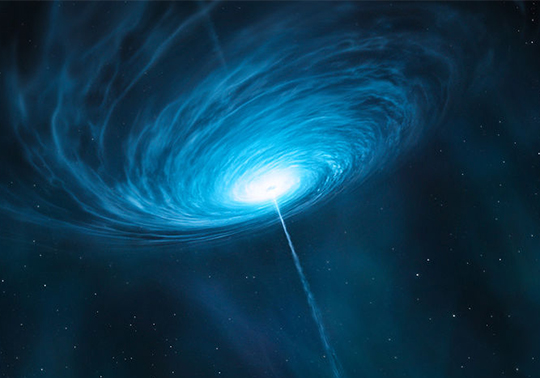Researchers of the Universitat describe the matter that circle the supermassive black hole from a quasar to almost a billion light years
- January 24th, 2017

An international team headed by researches of the University of Valencia has managed to establish the features and structure of the disk of matter located around the black hole of the quasar of the Einstein Cross (a distant object in the great luminosity universe). The estimation is based on observations made with the world’s biggest optical/infrared telescope, the Gran Telescopio Canarias and confirms other measurements about the size, the temperature and the transmitted light by these bodies located a billion light years away.
The research, published on the scientific journal The Astrophysical Journal, establishes the size of the hot/accretion disk of matter that is around the black hole of the quasar of the Einstein Cross. This way, the disk of hot matter has a radius of 6 light days (approximately 32 times the distance between the Earth and Pluto) and its temperature descends from the centre in a slightly more pronounced way than predicted by models.
“The estimations seem to indicate that the accretion disks of the quasars are a bit bigger than predicted by theoretical models”, states Héctor Vives, researcher on Department of Astronomy and Astrophysics of the University of Valencia, who first signed the article.
Quasars are astronomic distant objects that emit great quantities of energy, just as much or even more than the whole galaxy that harbours them. Because of the enormous distance between them, the size of their accretion disks cannot be measured by regular observation methods. This is why the effect of gravitational lens is used. This phenomenon derives from the Theory of General Relativity of Albert Einstein and is based on the capacity of the gravitational field to bend the light.
Among other conclusions of this work, Héctor Vives emphasises that the quasar region that emits medium infrared lights ─an accumulation of dust in toroidal shape that circles the accretion disk and has a much bigger size than this one─ has a medium radius of ca. 200 light days.
Furthermore, part of the dark matter (an invisible component whose origin is still uncertain and supposes 80% of the universe matter) in the central regions of the lens galaxy could be concentred in satellite or subhalo shape, as predicted by computer simulations. These subhalos ─which are 10% of the total halo of the galaxies─ suppose one of the predictions that have not been confirmed yet of the standard cosmological model.
The Einstein Cross is a system on which the gravity of a near galaxy alters the course of the light almost a distant quasar, acting like a gravitational lens and causing the creation of four images of it. The light of these images has gone through the central region (the bulb) of the near galaxy and its great quantity of stars also produces an additional lens effect. This provokes blinking on the brightness of the images, which are more pronounced the smaller the object emitting light is.
“Furthermore, because of the accretion disk temperature increases to its centre and a hotter object emits light in shorter waves, its apparent size is different depending on the longitude of the observed wave. This allows to measure how the temperature drops from the centre”, states Héctor Vives.
This way, in this study, the research team simulated brightness changes produced by the lens effect of the starts for different disk sizes and temperature profiles and calculated the bayesian probability of reproduce in each case the observations with the Nordic Optical Telescope (NOT). For this calculation it is necessary to establish which part of the brightness differences between the four images of the quasar is caused by stars effects and which part is caused by the global mass of the lens galaxy. With this purpose, the team measured the medium infrared with the CanariCam instrument in the Gran Telescopio Canarias (GTC). Because they come from a bigger region, the gravitational lens effect provoked by the stars has almost no influence.
Research career
This research has been made by the Gravitational Lens Group, whose main researcher is José Antonio Muñoz Lozano, Titular Professor of the Department of Astronomy and Astrophysics of the University of Valencia. The group studies from 2004 the properties of gravitational lenses and their applications on Astrophysics and Cosmology on national and international projects.
Article:
Observations of the Lensed Quasar Q2237+0305 with CanariCam at GTC. Vives-Arias, H., Muñoz, J.A., Kochanek, C.S., Mediavilla, E. & Jimenez-Vicente, J. (2016), ApJ, 831, 43.
http://adsabs.harvard.edu/abs/2016ApJ...831...43V
http://iopscience.iop.org/article/10.3847/0004-637X/831/1/43















